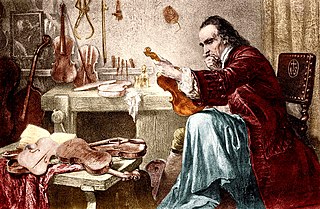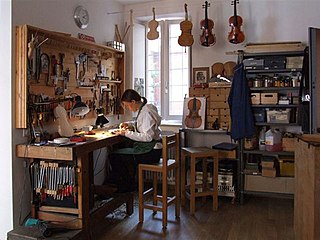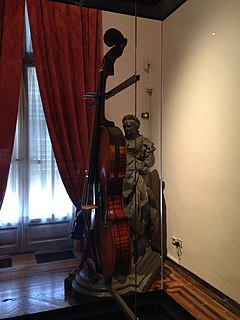Amati is the last name of a family of Italian violin makers who lived at Cremona from about 1538 to 1740. Their importance is considered equal to those of the Bergonzi, Guarneri, and Stradivari families. Today, violins created by Nicolò Amati are valued at around $600,000. Because of their age and rarity, Amati instruments are mostly kept in museum or private collections and are seldom played in public.

Antonio Stradivari was an Italian luthier and a craftsman of string instruments such as violins, cellos, guitars, violas and harps. The Latinized form of his surname, Stradivarius, as well as the colloquial Strad are terms often used to refer to his instruments. It is estimated that Stradivari produced 1,116 instruments, of which 960 were violins. Around 650 instruments survive, including 450 to 512 violins. His instruments are considered some of the finest ever made, and are extremely valuable collector's items.

A luthier is a craftsperson who builds or repairs string instruments that have a neck and a sound box. The word "luthier" is originally French and comes from the French word for lute. The term was originally used for makers of lutes, but it came to be used already in French for makers of most bowed and plucked stringed instruments such as members of the violin family and guitars. Luthiers, however, do not make harps or pianos; these require different skills and construction methods because their strings are secured to a frame.
The Guarneri, often referred to in the Latinized form Guarnerius, is the family name of a group of distinguished luthiers from Cremona in Italy in the 17th and 18th centuries, whose standing is considered comparable to those of the Amati and Stradivari families.

Giovanni Battista Guadagnini was an Italian luthier, regarded as one of the finest craftsmen of string instruments in history. He is widely considered the third greatest maker after Antonio Stradivari and Giuseppe Guarneri "del Gesù". The Guadagnini family was known for their violins, guitars and mandolins.

Il Cannone Guarnerius of 1743 is a violin created by the Italian luthier Giuseppe Antonio Guarneri of Cremona (1698–1744).
The Soil Stradivarius of 1714 is an antique violin made by Italian luthier Antonio Stradivari of Cremona (1644–1737). A product of Stradivari’s golden period, it is considered one of his finest. The Soil was acquired by Yehudi Menuhin in 1950. It was sold in 1986 to its current owner, Itzhak Perlman, who played this instrument while recording the Cinema Serenade with the Pittsburgh Symphony Orchestra in 1997.

Carlo Bergonzi was an Italian luthier and is the first and most prominent member of the Bergonzi family, a distinguished group of luthiers from Cremona, Italy, a city with a rich tradition of stringed instrument makers. Today his instruments are highly valued for their workmanship and tone. Although he was historically assumed to have first apprenticed with Hieronymus Amati or Antonio Stradivari, he is now known to have been the student of Vincenzo Rugeri.

Vadim Viktorovich Repin is a Russian and Belgian violinist who lives in Vienna.
The Ex-Marsick Stradivarius of 1715 is a violin named after Belgian violinist and teacher Martin Pierre Marsick (1847–1924), who owned the instrument made by Antonio Stradivari of Cremona. The instrument, valued at approximately $8 million USD, now belongs to the Fulton Collection and is played by James Ehnes.

Bartolomeo Giuseppe "del Gesù" Guarneri was an Italian luthier from the Guarneri family of Cremona. He rivals Antonio Stradivari (1644–1737) with regard to the respect and reverence accorded his instruments, and for many prominent players and collectors his instruments are the most coveted of all. Instruments made by Guarneri are often referred to as Del Gesùs.
Francesco Rugeri, also known as Ruger, Rugier, Rugeri, Ruggeri, Ruggieri, Ruggerius, was the first of an important family of luthiers, the Casa Rugeri in Cremona, Italy. His instruments are masterfully constructed. His violins are inspired by Nicolò Amati's "Grand Amati" pattern. Francesco was the first to develop a smaller cello design, which has become the standard for modern cello dimensions. Today, Rugeri's instruments are nearly as renowned as Nicolò Amati's instruments.

Carlo Bisiach (1892–1968) was a violin maker born in Milan Italy. Bisiach's work contributed to the rebirth of violin making in the region after the difficult times of World War I and World War II. After working with his father Leandro in Milan and then Siena, Carlo established himself at Florence in 1922. The most talented of Leandro's sons, Carlo went on to develop his own style quite separate from the Antoniazzi-derived work of his father and brothers.
Andrea Guarneri was an Italian luthier, musician and founder of the Casa Guarneri. He is the most important student of Nicola Amati and grandfather of one of the best luthiers, Bartolomeo Giuseppe Guarneri, del Gesù.

David Laurie - was a distinguished 19th century violin collector.
Dimitri Musafia is an artisan maker of violin and viola cases for his own company, Musafia. Residing in Cremona, Italy, he first trained as a violinist, and subsequently as a violin maker at the Stradivari Institute in Cremona, before self-teaching to make cases, beginning in 1983, on the basis of his previous studies.
Giuseppe Giovanni Battista Guarneri, better known as Giuseppe filius Andrea Guarneri was a violin maker from the prominent Guarneri family of luthiers who lived in Cremona, Italy.

Nicola Amati, Nicolò Amati or Nicolao Amati was an Italian master luthier from Cremona, Italy. Amati is one of the most well-known luthiers from the Casa Amati. He was the teacher of illustrious Cremonese School luthiers such as Andrea Guarneri and Giovanni Battista Rogeri. While no clear documentation exists for their being apprentices in his shop, Amati may also have apprenticed Antonio Stradivari, Francesco Rugeri, and Jacob Stainer, as their work is heavily influenced by Amati.

Anastasiya Petryshak is a Ukrainian violinist.

The Le Brun Stradivarius of 1712 is a violin made by Italian luthier Antonio Stradivari of Cremona (1644–1737). It is the only violin from Stradivari’s golden period known to have been owned and played by the violinist Niccolò Paganini. When sold at a Sotheby's auction in London in November 2001 it achieved one of the highest prices ever paid for a violin at auction, and became the most expensive instrument in Europe.













